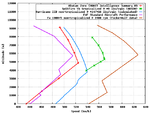Again let's not focus entirely on Ceylon for Hurricanes, because there are a fair number of other examples. In Jan-April '42, when fighting greatly died down on British fronts v Japanese, the Hurricane results, as given in Bloody Shambles combat by combat as I count, fighter to fighter:Wake Island would be comparable to the Glads in Malta, but did not the F4F usually have the advantage of height in Guadaulcanal when facing the Zeros as opposed to the Hurricanes which were surprised to find the Japanese over Ceylon and were attacking from below.
Zeroes: 2 combats over Ceylon, 27 Hurricanes lost for 3 Zeroes
Zeroes: 3 other combats with both sides known: 8 Hurricanes 3 Zeroes
Type 1's: 12 combats, 20 Hurricanes, 4 Type 1's
Type 97's: 9 combats, 8 Hurricanes, 5-6 Type 97's
1 Hurricane was lost in a combat with either Type 1's or Zeroes w/ no J loss, and 7 in combats where the Japanese side is not given. A few were Dutch Hurricanes, and a few combats were along with the AVG but only one has a real claim overlap, that's 5 v 6 Type 97's.
So the Hurricane combat effectiveness problem v the Japanese in the early campaigns was not a fluke of one situation. The Hurricanes were not outnumbered and surprised in every one of the 26 two-side documented combats, not nearly, but came out on the short end of all of them, except 2 combats v. Type 97's.
In the set piece interceptions over G'canal by F4F's, of Type 1 Land Attack Planes ('Betty') escorted by Zeroes, F4F's often had altitude advantage, but sometimes didn't. Plus, not all combats over G'canal involving land based planes in 1942 were those set pieces. Some were battles over convoys or carrier based planes of one side v landbased ones of the other, which occured at lower altitude. And a significant % were carrier fighters on both sides. At Coral Sea and Midway as already mentioned Lundstrom found the score between carrier based fighters was 14 (Zeroes, plus 2 Type 96's) v 10 carrier based F4F's. The numbers for Eastern Solomons and Santa Cruz are included above in Frank's numbers for all G'canal thru Nov 15 1942, but the carrier Zeroes did a bit better in the second two carrier battles. But overall the exchange in actions between carrier fighters was also around 1:1, where there was no tendency for altitude advantage on either side, and a general numerical advantage for the Japanese.
I suggest reading the references given above, count up and consider in their totality all the combats, and then see if a plausible case can be made that the Hurricane v F4F effectiveness difference can easily be explained by one factor like tactical situation. I don't see how.
Joe


 ... or ...
... or ...  A Flying Tank?
A Flying Tank?